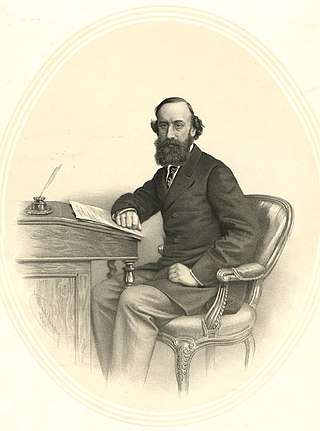
Earl Ferrers is a title in the Peerage of Great Britain. It was created in 1711 for Robert Shirley, 14th Baron Ferrers of Chartley. The Shirley family descends from George Shirley of Astwell Castle, Northamptonshire. In 1611 he was created a Baronet, of Staunton Harold in the County of Leicester, in the Baronetage of England. He was succeeded by his son Henry, the second Baronet, who married Lady Dorothy Devereux, daughter of Robert Devereux, 2nd Earl of Essex. On the death of her brother Robert Devereux, 3rd Earl of Essex, she became the youngest co-heir to the baronies of Ferrers of Chartley and the barony of Bourchier, which had fallen into abeyance on the death of the third Earl. Shirley was succeeded by his eldest son, the third Baronet. He died unmarried and was succeeded by his younger brother, the fourth Baronet. He was imprisoned in the Tower of London by Cromwell and died there in 1656. On his death the title passed to his eldest son, the fifth Baronet. He died at an early age and was succeeded at birth by his posthumous son, the sixth Baronet.

Earl of Drogheda is a title in the Peerage of Ireland. It was created in 1661 for The 3rd Viscount Moore.

Earl of Effingham, in the County of Surrey, is a title in the Peerage of the United Kingdom, created in 1837 for Kenneth Howard, 11th Baron Howard of Effingham, named after the village of Effingham, Surrey, where heads of the family owned the manor.

Baron Leigh has been created twice as a hereditary title, once in the Peerage of England and once in the Peerage of the United Kingdom. The first creation came in the Peerage of England 1643 when Sir Thomas Leigh, 2nd Baronet, was created Baron Leigh, of Stoneleigh in the County of Warwick. The Leigh Baronetcy, of Stoneleigh in the County of Warwick, had been created in 1611 for his grandfather and namesake Thomas Leigh. The latter was the second son of Sir Thomas Leigh, Lord Mayor of London in 1558, whose third son Sir William Leigh was the grandfather of Francis Leigh, 1st Earl of Chichester. The titles became extinct on the death of the fifth Baron Leigh in 1786.
David Leslie Moreton, 7th Earl of Ducie is a British peer, landowner, and farmer. He was a member of the House of Lords from 1991 to 1999. He was previously known as Lord Moreton.

Henry Herbert, 1st Earl of Carnarvon PC, known as The Lord Porchester from 1780 to 1793, was a British Whig politician who sat in the House of Commons from 1768 to 1780 when he was raised to the peerage as Baron Porchester. He served as Master of the Horse from 1806 to 1807 in the Ministry of All the Talents headed by Lord Grenville.

Henry John Reynolds-Moreton, 3rd Earl of Ducie, styled Lord Moreton between 1840 and 1853, was a British courtier and Liberal Party politician. He notably served as Captain of the Yeomen of the Guard from 1859 to 1866, and Lord Warden of the Stannaries from 1888 to 1908.

Admiral Maurice Frederick FitzHardinge Berkeley, 1st Baron FitzHardinge, was a Royal Navy officer. As a junior officer he commanded gunboats on the Tagus, reinforcing the Lines of Torres Vedras, in Autumn 1810 during the Peninsular War and, as a captain, he served on the coast of Syria taking part in the capture of Acre in November 1840 during the Oriental Crisis. He also served as Whig Member of Parliament for Gloucester and became First Naval Lord in the Aberdeen ministry in June 1854 and in that role focussed on manning the fleet and in carrying out reforms and improvements in the food, clothing, and pay of seamen.

Henry George Francis Reynolds-Moreton, 2nd Earl of Ducie, styled the Hon. Henry Reynolds-Moreton from 1808 to 1837 and the Lord Moreton from 1837 to 1840, was a British Whig politician, agriculturalist and cattle breeder.
Henry Haughton Reynolds-Moreton, Lord Moreton DL, was a British Liberal Party politician.
The Hon. Augustus Henry Moreton Macdonald of Largie, born Augustus Moreton, was a British Whig politician and writer.

Berkeley Basil Moreton, 4th Earl of Ducie, was a British peer and a politician and pastoralist in Australia. He was a Member of both the Queensland Legislative Assembly and the Queensland Legislative Council.

John Baron Dutton, 2nd Baron Sherborne, was a British peer.
William FitzHardinge Berkeley, 1st Earl FitzHardinge, known as The Lord Segrave between 1831 and 1841, was a British landowner and politician.
Charles Paget Fitzhardinge Berkeley, 3rd Baron FitzHardinge, styled The Honourable Charles Berkeley between 1861 and 1896, was a British Liberal politician.

Colonel Frederick Augustus Berkeley, 5th Earl of Berkeley was a British peer and military officer who served as the Lord Lieutenant of Gloucestershire from 1766 to 1810.

Thomas Reynolds-Moreton, 1st Earl of Ducie was the first Earl of Ducie.

Matthew Ducie Moreton, 1st Baron Ducie (1663–1735) of Moreton, Staffordshire, and Tortworth, Gloucestershire, was a British Army officer and politician who sat in the House of Commons between 1708 and 1720 when he was raised to the peerage as Baron Ducie.

Matthew Ducie Moreton, 2nd Baron Ducie of Tortworth, Gloucestershire, was a British Whig politician who sat in the House of Commons between 1721 and 1735 winning by-elections at four separate constituencies but never winning at a general election. He vacated his seat when he succeeded to the peerage as Baron Ducie.
Julia Reynolds-Moreton, Countess of Ducie, formerly Julia Langston, was an English noblewoman, the wife of Henry Reynolds-Moreton, 3rd Earl of Ducie.

















